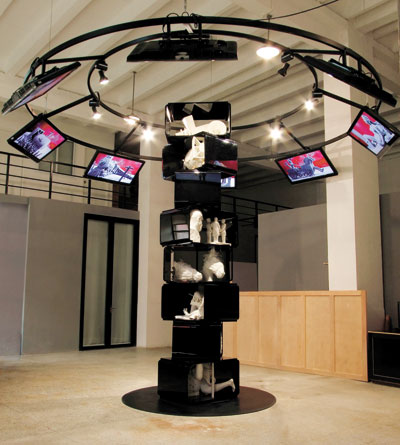
Cao Zhen
caozhen0806@126.com
VISIONS and Beyond: The Second Shenzhen Independent Animation Biennale, a cross-region art event showcasing video artists’ independent thought and critical thinking, is being held in OCT-LOFT.
This year’s biennale consists of three major sections: a competition, forums and an exhibition. Since the official launch in Beijing in April, the biennial has worked with fine art academies, art institutes, foundations, curators and scholars at home and abroad. Various public activities, including academic forums in Beijing, Hong Kong and Taipei, a series of lectures and two workshops in Shenzhen, have been held to much local acclaim and criticism from experts, scholars, curators and media outlets.
In October, 70 works from 64 directors were selected by three members of the preliminary jury for the competition. The final awards were announced Dec. 6 in OCT-LOFT, with Chinese artist Huang Bing winning the Independent Animation Innovation Award for his work “Stop Peeping,” Chinese artist Shen Jie winning the New Prominent Director Award for his work “Horse” and Iranian director Zarin Salahi winning Independent Animation Committee Grand Award for her work “Approaching Rest Area.”
The exhibition, which is being held at B10 in OCT-LOFT, showcases 55 works created by 42 artists from 11 countries and regions, including South Korea, Japan, the United States, South Africa, Germany and Singapore. Works in the competition section however are not on exhibition here.
Since its inception in 2012, the biennale has stressed that independent animation is a type of contemporary art that endows artists with a more open understanding of art and frees up the spirit of creation.
The first edition of the biennale in 2012 mainly exhibited single-channel animation works shown as a single image on a conventional TV or projection screens. This year’s exhibition showcases more installation works, involving either an environment, several distinct pieces of video presented separately or any combination of video with traditional media such as sculptures. Forms of the exhibited works are not limited to animated cartoons but also include documentaries, experimental movies and slideshows.
“The first edition of the biennale in 2012 reviewed the 10-year development of Chinese independent animation, the artists’ freedom of approach and their adaptation of new narration. This year, we are focusing on video art presented with other disciplines such as installation, design, digital art or other documentary aspects of artistic practice,” said Dong Bingfeng, the chief curator of this year’s biennale.
In the exhibition hall, Chinese artist Feng Mengbo is showing his documentary “Donkey_ment” on a three-screen installation. Obsessed with traditional Chinese shadow plays, he filmed a shadow-play stage in Shaanxi Province from three directions: from the front, from behind and from the left side. Three projectors play the documentary in three directions, which lets visitors see the whole stage of the shadow plays.
At the opening ceremony of the exhibition Dec. 6, Feng, who has collected numerous pieces of old Chinese publicity and educational slides, presented a live slideshow accompanied by several Chinese publicity audio materials and songs popular in the 1950s and 1960s. The show was recorded on video and now is on exhibition at B10. Feng said watching slideshows was one of his hobbies in childhood, even though all the shows were publicity and educational, because he seldom watched entertaining movies at that time.
The exhibition also reviews German animation during the Weimar Republic period (1918-1933) by showing short animated movies created by Lotte Reiniger, Walter Ruttmann, Viking Eggeling, Hans Richter, Oskar Fischinger, Rudolf Pfenninger and Berthold Bartosch. “German animation is internationally renowned mainly for the powerful artistic impetus that developed during the Weimar Republic period,” said Dong. “Visitors can enjoy German abstract animated films in the early 1920s, which are non-narrative visual/sound experiences with no story and no acting. They can also watch German silhouette animation in which the characters are only visible as black silhouettes.”
|

